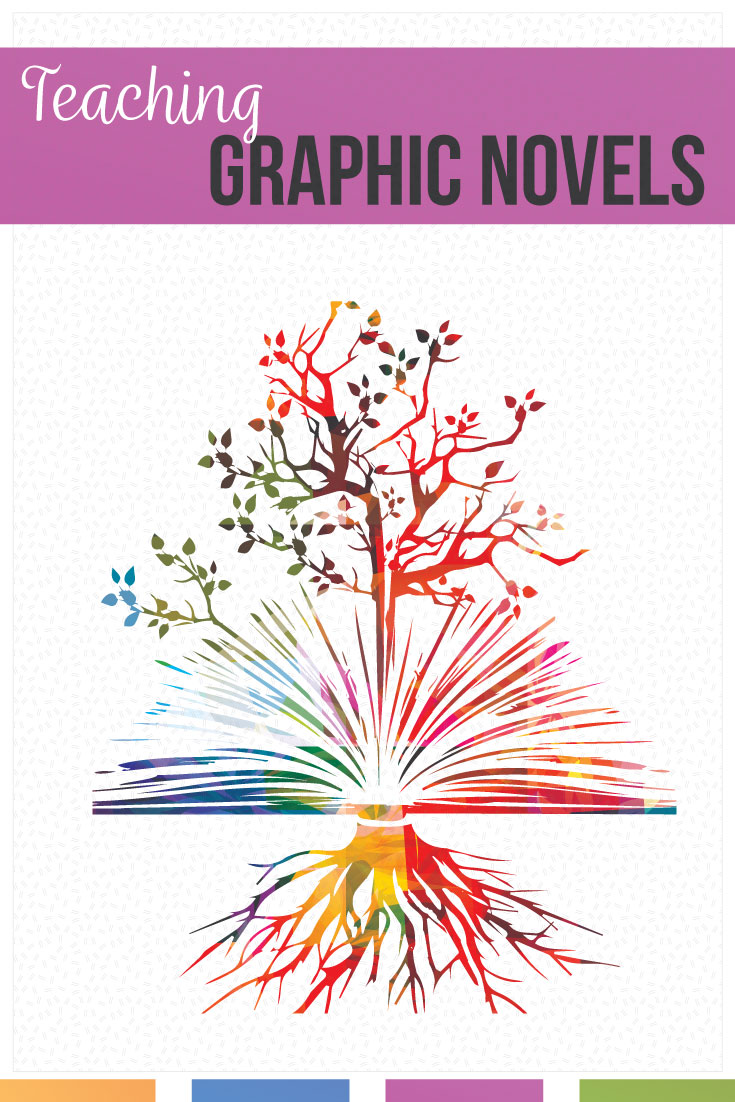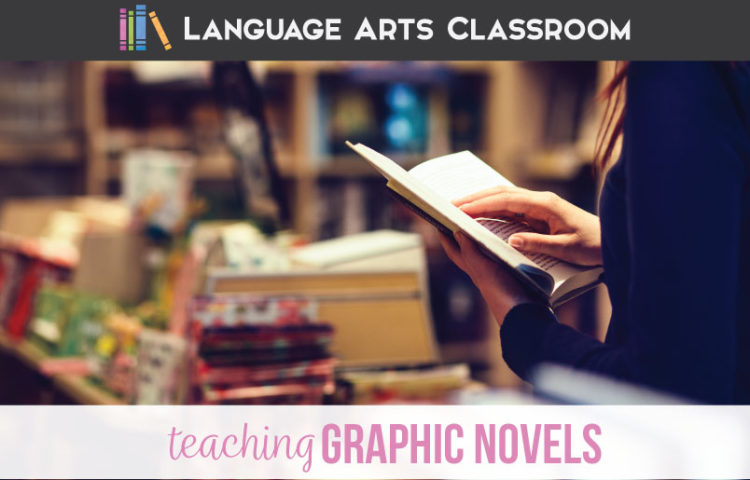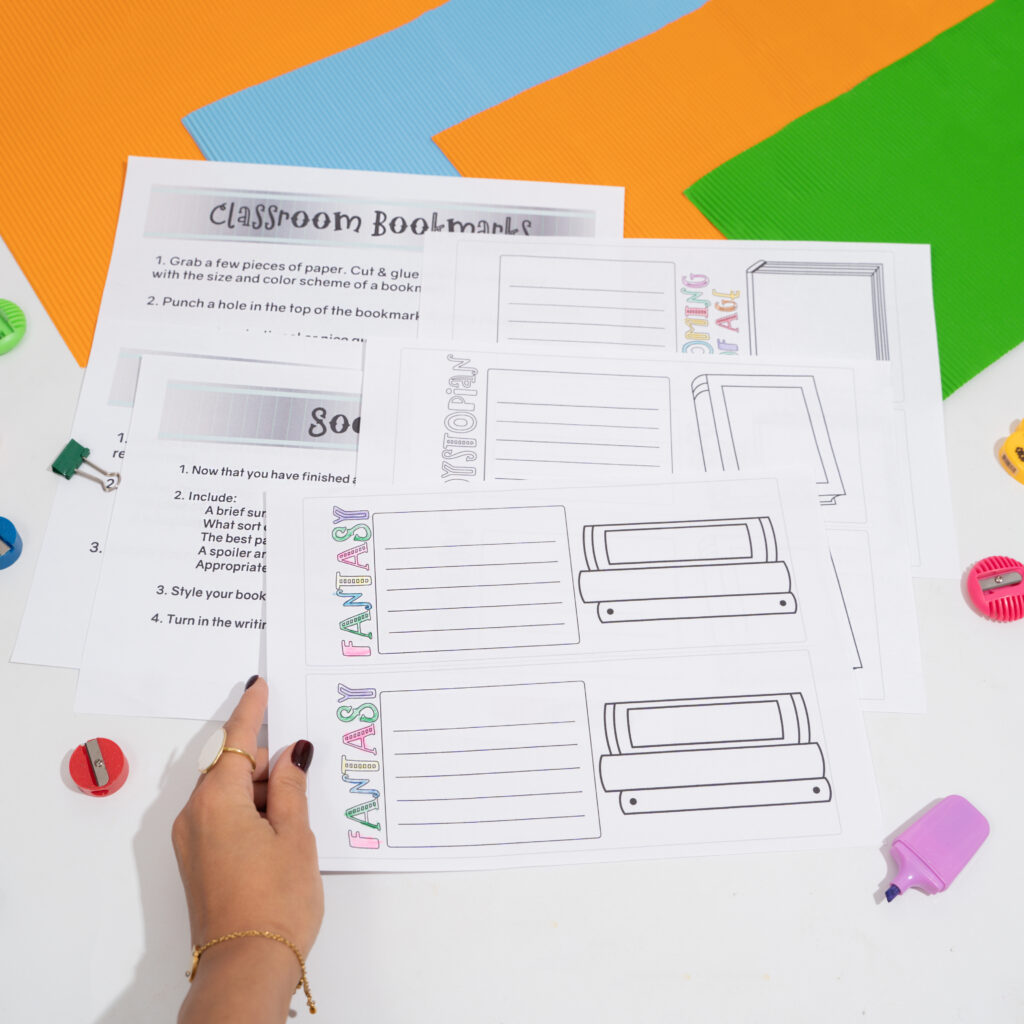Teaching graphic novels? I have taught graphic novels and have them in my classroom library.
The picture below illustrates how I feel about graphic novels: colorful, with appealing pictures and deep roots. I personally do not sit and read graphic novels, but I appreciate them. Art was never my strength, and the energy and depth that the pictures have. . . I’m awestruck by most graphic novels.
Teaching graphic novels in the English classroom has improved many of my lessons on visual literacy. I already keep comic books in my classroom library for my creative writing course. Students of all ages enjoy when I read pieces of graphic novels as extension activities, at the end of unit (on any subject, really!), or at the end of class periods.

What are some benefits of teaching graphic novels in the classroom?
Teaching graphic novels in the classroom offers numerous benefits. They engage visual learners, promote critical thinking and analysis, improve reading comprehension, and enhance creativity. Graphic novels also provide a gateway for reluctant readers to develop a love for reading and storytelling. No matter what your units of study, you can probably add a graphic novel.
Another benefit is the engagement when my students read them. This year, I am teaching the graphic novel version of The Odyssey by Gareth Hinds. Our conversations are rich, and my thought is that the images end confusion amongst students. The culture, the beliefs, and the gods and goddesses are often not part of students’ schema. The pictures alleviate some confusion, and we can focus on other concepts. Even in high school, graphic novels work.
Plus, graphic novels can be used for First Chapter Friday to show students a new type of genre. When I read a graphic chapter for FCF, I often show the pictures as I read. I don’t read an entire chapter, but instead I read a few pages and discuss the details with students. Using graphic novels in the classroom is a great way to differentiate instruction for learners, both in terms of reading and assessment. Sometimes during First Chapter Friday, the books introduce students to a new genre.
How can I engross learners with graphic novel books?
No matter how you use graphic novels in your secondary classroom, you will find an audience. Plus. graphic novel activities are diverse! The vocabulary included in the prose allows for unplanned discussions.
The books are more than superheroes, but of course those exist too. You’ll find true stories that build empathy. You can also discover historical ones that add to literature lessons. If you need independent reading choices, graphic novels work too.
Reflecting on my first year teaching graphic novels, I’ve found four ways to gain meaning from fabulous learning tools. Below, I’ve included ideas for teaching with graphic novels.
Give the colors and fonts an overview.
Everything in a graphic novel has a purpose. When I distributed the books for students, we analyzed the colors on the front and back. What could we learn from the initial choices?
Then, as we read, we realized that certain characters had repeated colors. Were the colors telling readers their ages? Their personalities? In a graphic novel, I feel like the color choices are part of the indirect characterization.
The fonts matter, too. Some fonts are standard, but whispers and asides might be wavy. A “thwack” sound effect might be bubble letters floating away. These effects are something that students see in advertising and media, and I found it important to highlight that the author was using the font to send a message.
Since students encounter images with particular colors and fonts daily, take the opportunity to connect your subject matter to their lives.
Notice the images.
Images do not replace the message. Instead, the images and the layout emphasize and reinforce the message. Often, pages won’t have words. Students must draw conclusions from the pictures.
They can do this, and that is because the images are so detailed. Discuss these images, and then discuss the various interpretations. Often, students have conclusions from both the images and the words. Talk about how they are intertwined and affect each other.
A turning point with any of your favorite graphic novels will be when students relate literary devices to the images. At the end of the unit, ask students to flip back to the beginning of the book. What do they notice? They probably will see the exposition or early stages of character development in the images.
Allow students to explore.
Good readers explore books. They reread sections and hunt for pieces about characters, clues about the setting, and for Easter eggs. I adore combing through a book and searching for missing pieces, but some students have not found that joy yet.
A graphic novel encourages students to explore. Students can identify characters from the colors and flip through the graphic novel. They reread, which increases understanding and enjoyment. The visual storytelling encourages engagement.
If possible, request graphic novels for your classroom or department. Both middle school and high school English classrooms benefit from exploration of graphic novels.
Research, and look at these resources!
I spoke with my librarian for suggestions concerning graphic novels. So! Start with coworkers and investigate practical ideas for including graphic novels in your classroom. I’ve never received formal training in teaching graphic novels, and talking through the process with coworkers helped.
A huge resource for teachers is this graphic novel resource for librarians. That website also has a presentation to show others why graphic novels are important to readers. A short article to perhaps send parents is from Healthy Teen Network.
As I browsed research, I learned that many teachers paired graphic novels with a webinar to hit a variety of standards. As someone who loves digital literacy, I love this idea.
I have always had graphic novels in my classroom library, but this year was my first time teaching graphic novels. My classroom implementation went well!
Can a comic teach English language arts students?
Graphic novels are similar to comic books, and both are helpful in teaching. If you need to scaffold a topic like empathy and inclusion, the book American Born Chinese will work. A bit of searching, and you can enhance your current lessons.
By adding graphic novels to your teaching toolbox, you’ll help your students develop important reading and critical-thinking skills. They not only motivate students to read, they support learning in your classroom and help your students develop the skills they need to read and comprehend even more challenging works of literature.
These ideas for teaching graphic novels are what I found beneficial, but I’d love to add more! What works for you while teaching the best graphic novels?
This post contains affiliate links. Please visit my disclosure page.


